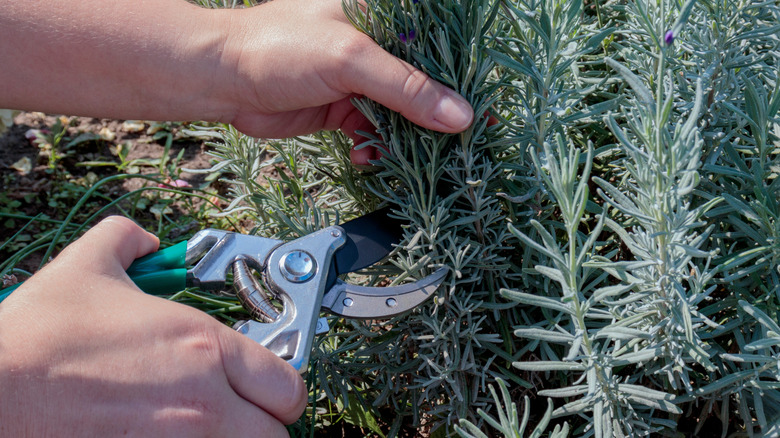The Lavender Variety That Thrives In Conditions That Kill Lawns
If you've got patches of lawn that dry out, burn under the sun, or never seem to thrive no matter how much effort you put in, it might be time to rethink what belongs in those spaces. While turfgrass struggles in hot, dry, and nutrient-poor areas, one plant doesn't just survive; it thrives. Spanish lavender (Lavandula stoechas) is a heat and drought-tolerant Mediterranean native that flourishes in the exact conditions that cause traditional lawns to fail.
To be clear, this isn't a turf replacement in the walkable, mowable sense. Spanish lavender won't form a carpet you can picnic on. Still, it's an excellent eco-friendly grass alternative for problem lawn zones, places where the grass never quite "takes," where water runs off instead of soaking in, or where you're tired of trying to keep something green that just doesn't want to grow. It offers a low-maintenance, eco-conscious solution for these frustrating areas.
Spanish lavender produces dense mounds of silvery foliage topped with vibrant purple blooms that attract bees, butterflies, and admiration from passersby. It's ideal for sunny curb strips, rocky borders, dry slopes, or any hard-to-irrigate part of your landscape. Once established, it needs little water, no fertilizer, and minimal attention. Its aromatic presence, pollinator appeal (particularly bumblebees), and ability to handle poor soil make it a smart addition to any garden struggling with dry, uncooperative lawn zones. If you're looking to beautify the rough patches without increasing your workload, this resilient plant could be the perfect fix.
How to use spanish lavender in lawn problem areas
Spanish lavender is happiest in locations with full sun and excellent drainage. It naturally thrives in sandy, gritty, or rocky soils that can be challenging for other plants. Overly rich or moist conditions can cause root rot and leggy growth, so it's important not to baby it with too much water or compost. This makes it a perfect fit for areas with poor soil or limited irrigation, especially where turf has failed repeatedly.
When planting, space your lavender about 18 to 24 inches apart to allow for good airflow and natural mound formation. These plants will slowly fill out, creating a soft, shrubby appearance that suppresses weeds and adds structure to the landscape. While it may not withstand regular foot traffic like a traditional lawn, it's ideal for borders, sloped garden beds, and sun-drenched areas where low-maintenance plants are most needed.
Spanish lavender is a perennial plant in USDA Zones 8 and 9, although it may still benefit from some additional cold protection. It's a fantastic option for gardeners trying to conserve water, reduce lawn care, or simply enhance their yard with more color and pollinator-friendly options. For especially dry climates, grouping several together can create a cohesive and intentional alternative to the usual patchy lawn look. It's the perfect addition to your low-maintenance landscaping.
Ongoing care and seasonal tips
One of the best features of Spanish lavender is how little it asks of you once it's established. Unlike turfgrass, it doesn't require mowing, fertilizing, or weekly watering. Less is often more with this plant. Deep, infrequent watering is more effective than regular, shallow sprinkling, and it will perform best when allowed to dry out between waterings. This makes it a fantastic drought-resistant alternative for your yard.
Maintenance is mostly seasonal. After its primary bloom in late spring to early summer, trim spent flower spikes to encourage a tidy shape and possibly trigger another flush of blooms. Use sharp, clean shears and avoid cutting into the woody base, as it doesn't regrow well from old wood. Prune lightly again in early fall if needed, but stop before the first frost to avoid cold damage. You also won't need to worry about feeding Spanish lavender. It's adapted to low-nutrient soils and will perform poorly with excessive fertilizer. Pests and diseases are rare as long as the plant gets plenty of airflow and sunlight.
For gardeners seeking to reduce their reliance on high-maintenance grass, lavender provides a hardy, visually striking alternative. It transforms dry, underperforming areas into fragrant, pollinator-rich spaces, all with almost no fuss. While it's not a lawn substitute in the traditional sense, it is an elegant solution for some of the most challenging spots in your yard.


